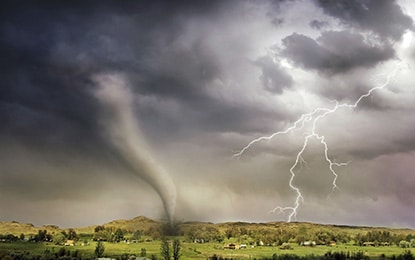The Different Types of Tornados
May 04, 2022
Tornados are extreme weather phenomena that happen all across the world. They happen the most in the US, with around 1,200 touching down every year. Tornados are dangerous and typically leave a path of destruction in their wake. However, it might surprise some to find out that there are actually different types of tornados. Tornados are split up into two categories, supercell tornados and non-supercell tornados.
Supercell Tornados
Supercell tornados are the most common, and unfortunately the most dangerous. They form from supercell thunderstorms. The thunderstorms pull low-pressure air high up into the clouds, leaving cooler hi-pressure towards the ground. Then, the air pressure tries to equalize resulting in a horizontal tube of rotating air. Once an updraft lifts the horizontal tube to stand on its side, the tornado truly starts to form. The circling air starts pulling down condensation from the skies, and once it reaches the ground it’s a full tornado.
Non-Supercell Tornados
Some tornados don’t start with thunderstorms. When there are low-pressure and high-pressure areas near the ground, they can start to circle each other. The rotating air doesn’t do much until an updraft pushes it up into the clouds. Once the circling wind connects to the clouds, it’s officially a tornado. Land spouts and water spouts are both non-supercell tornados.
How are Tornados Rated?
To measure the strength of tornados, experts examine the damage the cyclone has caused. From that, they can determine the approximate wind speeds of the storm. Those numbers are then put onto the “Enhanced Fujita Scale“, which goes from 0 to 5. In 2007, the National Weather Service put together the EF-Scale, creating a more consistent and accurate scale than the original Fujita Scale. The EF-Scale uses 28 different indicators of damage, including tree and building type.
Summary – The Different Types of Tornados and How They’re Rated
The two types of tornados are supercell tornados and non-supercell tornados. The main difference is whether the tornado forms from a supercell thunderstorm or not. Supercell tornados are typically more dangerous, and unfortunately typically the most common. All tornados are rated on the Enhanced Fujita Scale, which experts use to determine approximate wind speed through the damages a cyclone leaves behind. That means tornado ratings are based on how destructive the storms are.
Call a Professional
At Honey Bees Roofing & Solar, extreme weather fascinates us since we repair storm damage frequently. All storms can do serious damage to your home. Repairing a home after a storm is often a very lengthy and trying process. This process can be quite stressful, but Honey Bees Roofing & Solar is here to help. We’ll meet with you and your insurance adjuster on-site to discuss the restoration plan for your home. We’ll help you navigate the homeowner’s insurance claims process. We specialize in ensuring you receive everything you’re entitled to under your insurance policy. If you need help with roof repairs or understanding the roofing insurance process, Contact Honey Bees Roofing & Solar online or give us a call today at 817-668-6131! We would be more than happy to help!
